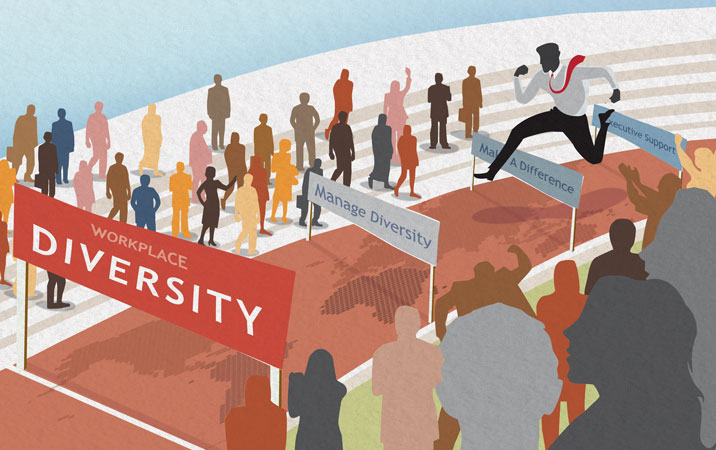Diversity management is a key instrument to position your company as a preferred employer. Fail to recite this mantra and you risk losing the attention of the majority of young graduates in Europe today.
Insert the words “diversity management” as a Google search term and you will receive about 1.5 million hits (early January 2012). Of these 1.5 million websites, 600,000 (i.e. 40%) were added in 2011. Diversity management is en vogue. Every self-respecting company today has a diversity policy document and most large employers have one or more D&I (Diversity & Inclusion) officers. Chief executive officers and HR directors of companies such as Axa, Ford, Hewlett Packard Europe, Novartis and Renault have given interviews or even posted YouTube videos in which they profess their commitment to diversity and inclusion at their companies.
Fail to recite the diversity management mantra and you risk losing the attention of the majority of young graduates in Europe today. In many countries university graduates are no longer predominantly white males, hence diversity management is a key instrument to position your company as a preferred employer.
However, turning diversity rhetoric into action has been more difficult than most companies are willing to admit openly. Companies are facing a triple hurdle in implementing diversity management policies and most companies have only taken the first hurdle.
First hurdle: obtain top executive support
The first hurdle to establish a credible diversity policy is to get high level buy in. While this hurdle has been taken at many large and public corporations, numerous firms still struggle today to overcome this challenge.
There have been three ways in which companies have taken this first hurdle. At IBM, top management took the initiative. In 1953, Tom Watson Jr. wrote a letter to the governors of two U.S. Southern states explaining that he would only invest in new plants if these states allowed equal opportunities for black and white employees. In 1956 Tom Watson Jr. went on to become CEO and IBM has remained a diversity and inclusion leader ever since.
Appointing a non-male or a non-white CEO has been another way to drive the diversity agenda. By appointing Indra Nooyi (CEO at Pepsi), “Atomic” Anne Lauvergeon (CEO at Areva, France’s nuclear power company) and Anshu Jain (co-CEO at Deutsche Bank) these companies effectively told young women and men around the world: “join us and if you work hard, one day you may be our next CEO.”
Finally, an independent and authoritative voice hinting at the existence of a business case for diversity has helped greatly. In particular the four McKinsey reports “Women Matters” (which can be downloaded freely) provided credible boardroom arguments — even if the academic quality of these studies may be questioned.
Second hurdle: make a difference
After the first hurdle has been taken, nice words have been spoken, and the image brochures have been printed, it is time to show that the diversity commitment leads to measurable change. This is easier said than done.
In order to keep things manageable, firms typically select one aspect of diversity. Most diversity managers understand that there are many dimensions of diversity, such as gender, age or nationality. Yet at most companies, progress in one area is particularly necessary. Also most managers think that if they focus on several dimensions at the same time, they do not focus at all and are less likely to succeed. As we will see below, that is a miscalculation.
Most European companies understand diversity management primarily in terms of gender diversity. However, when trying to put words into action many companies are finding it very difficult to increase the percentage of female managers. This is not necessarily due only to internal resistance. Unfortunately experienced female managers are rare and companies are fishing in the same talent pool, competing for female graduates’ and female managers’ attention.
Moreover companies often start from very low levels of diversity. Hiring diverse university graduates makes perfect sense but effects may not be visible for another fifteen years. Several years ago the German subsidiary of a large European consumer goods company decided to increase the share of female middle managers from 17 to 50 per cent over the next five years, and to raise the share of female senior managers from 21 to 35 per cent during the same period. It had not realised that it could only obtain this goal by taking three draconian measures at the same time. First, the subsidiary would have to hire exclusively female university recruits. Second, it would have to solely promote women to management positions. Third, it would have to accept that a large number of competent men would leave the organisation. At many companies promoting gender diversity cannot be a quick fix but is for the long haul.
A minority of firms have rather focused on nationality or ethnical diversity. Increasing nationality diversity has proven a major challenge in e.g. the U.S. or Germany, but Dutch and especially Swiss firms have shown that it is possible to make substantial progress here. Today, about half of all top executives at the largest 100 Swiss firms are non-Swiss nationals.
It is not surprising Swiss companies have made such progress in this respect. They can draw executive talent from surrounding markets speaking the same language, although German and Austrian managers do need some time before they understand the Swiss-German dialect. Also large Swiss firms typically have very high degrees of internationalisation. Our research shows that the advantages of nationality diversity at the top management team particularly set in at firms with a very substantial share of their revenues abroad.
Third hurdle: manage diversity
Diversity policies are based on the assumption that a diverse workforce creates benefits for firms which are ultimately translated into productivity or performance advantages. This is referred to as the value-in-diversity perspective. Due to the selective publicity that e.g. the McKinsey studies obtained, diversity managers gladly subscribe to the value-in-diversity perspective.
Unfortunately the business case for diversity is less well developed than many believe. Academic research shows inconsistent findings when it comes to the effect of diversity on team or firm performance. High levels of diversity may have either positive or negative effects on performance, depending on the salience of different background characteristics within the team and the impact of such characteristics on team dynamics. Researchers need to develop a more fine-grained theoretical understanding of the possible positive and negative, as well as the overall, effects of diversity on firm performance. They also need to improve the methods and instruments to capture contradictory effects simultaneously.
In short, measuring, let alone managing, the diversity-performance relationship is very complex and still poorly understood. However our research shows two key directions for developing diversity management.
First, our research suggests that internal diversity programmes within organisations are often working. Recently I talked to the European Head of D&I at a large U.S. consumer good company who complained that she can only fill up management positions internally. She is luckier than she realises. While diversity programmes can only accelerate internal careers to a certain extent, and only solve the acute numbers problem slowly, they serve two purposes.
On the one hand, internal diversity programmes express senior management’s trust in the participants of such programmes, and as such can act as a retention vehicle. On the other hand, and more importantly, internal diversity programmes are effective mechanisms of introducing future senior managers to different parts of the organisation. In our research we find that female and foreign top executive appointments from within the company lead to significantly higher firm performance than external recruitments. Future research needs to identify specific features that increase the success of these internal diversity programmes.
Second, our research suggests that while the link between one dimension of diversity (e.g. gender) and firm productivity or performance may be difficult to make, the picture changes if one manages different aspects of diversity at the same time. We looked at the performance effects of top management team composition in five countries (Germany, Netherlands, Switzerland, UK and U.S.). We found that while the performance effects of individual diversity dimensions such as gender or age is often tenuous, the combined effect of these three dimensions is significantly positive.
This indicates that the sum of diversity is more than the parts provided diversity is understood to include different aspects simultaneously. A singular approach to diversity management, i.e. focusing on and measuring the effect of one aspect only, will be difficult to pull off and is unlikely to produce the anticipated positive results.
Overcoming the triple hurdle
Few companies have identified the triple hurdle. Too often, D&I officers feel isolated or powerless to deliver the expected results. Outside help is available but advisors and diversity networks frequently charge hefty fees, are associated with consultants seeking to market their products, or provide insufficient depth.
In Switzerland a group of global and regional heads of D&I has gone a different way. Together with the University of St Gallen these Heads of D&I are working to benchmark their programmes, and analyse their internal data in order to identify the diversity value drivers in their organisations by using sophisticated statistical methods. Ultimately this project will help these companies to position themselves better as preferred employers.
In conclusion, if the case for diversity is not to run out of steam, progress is necessary along two dimensions. First, the diversity agenda needs to be broadened and not only focus on the gender dimension, even though the gender imbalance continues to pose a formidable challenge at most companies. Instead, companies need to look for ways to manage other diversity aspects such as age, ethnicity and nationality as well. Second, the business case for diversity needs to be much more concrete. Top executive support and goodwill are great, but concrete evidence showing how and why diversity helps to drive the organisation’s productivity or performance is better.
About the author
Professor Winfried Ruigrok is Dean of the Executive School of Management, Technology & Law at the University of St Gallen, Switzerland. He is also a professor of international management at this university. St Gallen was ranked no. 12 in the Financial Times European Business School ranking (December 2011) and is one of the largest twenty business schools in the world in terms of custom executive education. His contact details are: [email protected], www.fim.unisg.ch and www.es.unisg.ch








![“Does Everyone Hear Me OK?”: How to Lead Virtual Teams Effectively iStock-1438575049 (1) [Converted]](https://www.europeanbusinessreview.com/wp-content/uploads/2024/11/iStock-1438575049-1-Converted-218x150.jpg)

















![“Does Everyone Hear Me OK?”: How to Lead Virtual Teams Effectively iStock-1438575049 (1) [Converted]](https://www.europeanbusinessreview.com/wp-content/uploads/2024/11/iStock-1438575049-1-Converted-100x70.jpg)




